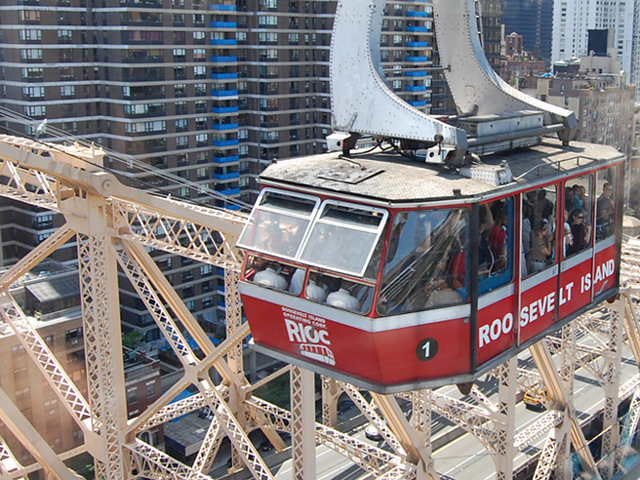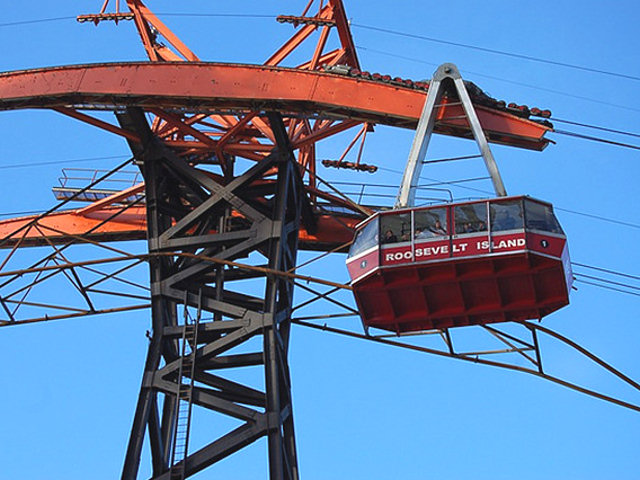Roosevelt Island Tramway - New York
One of the last things you expect to see is an Alpine cable car system that would look more at home in the Swiss and Austrian Mountains in Europe. The Roosevelt Island Tramway is an aerial tramway in New York City that spans the East River and connects Roosevelt Island to Manhattan. Prior to the completion of the Mississippi Aerial River Transit in May 1984 and the Portland Aerial Tram in December 2006.

It was the only commuter aerial tramway in North America. Roosevelt Island Tramway was born in 1976 as a means to shuttle residents to and from Manhattan. The tramway was only supposed to be temporary until the subway station opened. But when the subway finally connected to Roosevelt Island in 1989, the tram was to popular to discontinue. Over twenty years later, the Tram has serviced over 20 million passengers and provided passengers with a breathtaking view of New York as they are quickly shuttled between Roosevelt Island and Manhattan. The tramway is now run by RIOC (the Roosevelt Island Operating Corp).
The Tramway was built by the Swiss company Vonroll under designers Prentice and Chan and Ohlhausen in 1976. Holding 125 people, the Roosevelt Island Tram is the only commuter cable car in North America. It travels a distance of 3,100 feet at an average speed of 16 mph in 4 1/2 minutes. It rises to a maximum height of 250 feet and travels at certain points parallel and slightly above the adjacent Queensboro Bridge, linking Long Island City, Queens, and 59th Street in Manhattan.
The tram ride will start out on the Roosevelt Island side and ride into Manhattan. The Roosevelt Island station is at grade and is located on the south end of the island on Main St. (incorrectly called West Road on some maps) and is the southern terminal for the RIOC Roosevelt Island Bus. Upon entering the station, either by steps of by ramp, there is a station agent booth to our right. The usual Metrocard machine and turnstile equipment are present. After passing through the turnstiles, we find ourselves on a high platform somewhat like a train station platform. There are two wires spanning the entire length of the line, one on the right side of the island platform and one on the left. A tram comes on the right side and we board it.

Inside the tramcar, there are very few seats, but many poles, rings, and bars to hold onto. The tramcar can hold about 115 people standing and about 10 sitting. After everybody in the station at the time boards the tram (which can take a very long time), the operator gets in and starts it up, then the doors close. You depart the Roosevelt Island station at a slow speed, but after we are out of the station, we begin to pick up speed. We first cross over Main St., and then begin a gradual rise to Manhattan. Just after crossing Main St. You cross the West Channel of the East River. The Queensboro (59th St.) Bridge is to our left and the apartment buildings on Roosevelt Island and Manhattan are to our right. After crossing the river and passing our peak at 250 feet, you begin a gradual descent over the Manhattan streets, in a small right of way between 59th and 60th Sts.
You cross the FDR, York Avenue, and first Avenue respectively, and then the tram slows down. You slowly cross over the entrance ramp to the Queensboro Bridge and Second Avenue so close to the ground that it appears the tops of trucks will hit the bottom of our tram (they don't of course). Then, immediately after passing over 2nd Av., a loud bump is heard as our tram locks into the station at 60th St/2nd Av., which is 'elevated'. This station has two side platforms and an island platform and the doors open on both sides of the tram. Normally, people exit to the right and enter from the left, so we go with the flow of traffic. There are turnstiles at the end of all three platforms, and then staircases down to the street. There are exits onto 60th and 59th Sts.
Each cabin has a capacity of up to 125 people and makes approximately 115 trips per day. The tram moves at about 16 mph (26 km/h) and travels 3,100 feet (940 m) in 4.5 minutes. At its peak it climbs to 250 feet (76 m) above the East River as it follows its route on the north side of the Queensboro Bridge, providing views of the East Side of midtown Manhattan. Two cabins make the run at fifteen minute intervals from 6:00 a.m. to 2:30 a.m. (3:30 a.m. on weekends) and continuously during rush hours. It is one of the few forms of mass transit in New York City not run by the Metropolitan Transportation Authority, but uses that system's MetroCard. The tram is operated by Interfac on behalf of the Roosevelt Island Operating Corporation of the State of New York, a state public benefit corporation created in 1984 to run services on the island.
Beginning in the mid-1970s, Roosevelt Island was redeveloped to accommodate low- to mid-income housing projects, necessitating the construction of a new public transit connection to the city. The trolley tracks had deteriorated too much to be usable and the planned subway connection to the island had not yet been completed. The tramway was built in 1976 by the Swiss company Von Roll as a temporary transportation solution to the island. As the subway project fell further behind schedule, the 'Tram' became more popular and was converted into a permanent facility. The subway connection to the island was finally completed in 1989.
The tram was the last holdout for the use of tokens in the New York City transit system. Initially it used a special token, later the standard one for subways and buses. Although tokens were phased out in favor of the MetroCard by 2003, the tram would not start accepting MetroCards until March 1, 2004. The fare is the same as that on the subways, U.S. $2.25 for a one way trip. During the 2005 New York City transit strike, the tramway was one of the few intra-city public transportation systems still in operation.
On April 18, 2006, at about 5:22 p.m. EDT, two trams were stuck over the East River for seven hours because of mechanical problems, trapping 69 people. Rescue baskets capable of holding up to 15 people were sent up to the stranded cable cars at 10:55 p.m., with children and elderly going first, and each rescue taking about 20 minutes. These baskets also carried supplies to the trams, such as blankets, baby formula, and food, for the remaining passengers. Passengers on the Roosevelt Island-bound tram were rescued by about 2:55 a.m. on April 19, while those on the Manhattan-bound tram were not rescued until 4:07 a.m.
The April 2006 incident was the second time in eight months the tram system lost power. On September 2, 2005, more than 80 people were trapped on the tram for over 90 minutes. After that incident, state inspectors cited the Roosevelt Island Tramway for not having an operational diesel backup, or MG set system. The State Department of Labor said the system did not pass electrical inspection and could not run when the April 18 power outage took place
The tramway suspended operations after the April 2006 incident, re-opening on September 1, 2006. The tram's backup electrical systems were refurbished, and 'in case of an emergency, each car now is equipped with blankets, water, food and a toilet with a privacy curtain. Car attendants will carry cell phones with their radios.'
One change to the cars has been very controversial among island residents. As part of the new paint job, the logo on the cars was changed from "The Roosevelt Island Tram" to "RIOC" (short for Roosevelt Island Operating Corporation).
The tramway was featured prominently in a climactic battle in the 2002 film Spider-Man, in which the Green Goblin throws Mary Jane off of the Queensboro Bridge and Spider Man must choose between saving her or passengers on the Roosevelt Island Tramway. The Spider-Man film was not the first appearance of the tramway; The House on the Edge of the Park (1980) shows the tram at 6:07 minutes into the film as how it appeared in the late 1970s. The Sylvester Stallone thriller Nighthawks (1981) depicted the tramway as a terrorist target where United Nations delegates were taken hostage.
It was used in the opening credits of City Slickers (1991). In the 1994 film Leon (The Professional) it can be seen when Natalie Portman's character, Mathilda, is traveling on it alone. It also appeared in the 2005 horror movie Dark Water. In the comic Kingdom Come, the climactic battle of Volume 1 takes place on and around a similar system in downtown Metropolis.
The tram also figured prominently in the Universal Studios Florida theme park attraction Kongfrontation, which opened in 1990 but was removed in 2002. The ride consisted of passengers boarding a recreation of a Roosevelt Island tram where they promptly came face-to-face with King Kong. The recreation did take certain liberties with regard to accuracy - the real trams, for example, do not have seats (though they do have benches at either end).
Travel books

